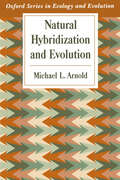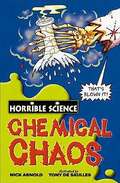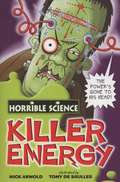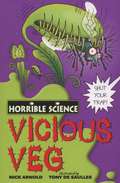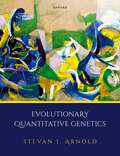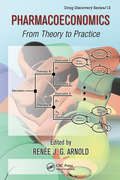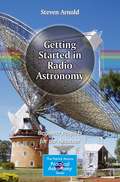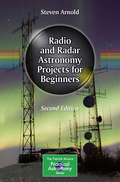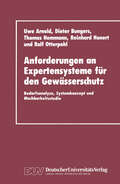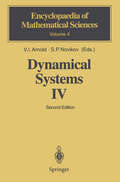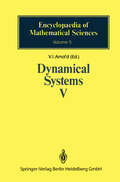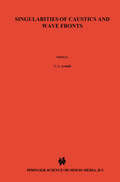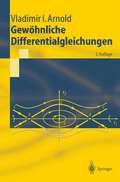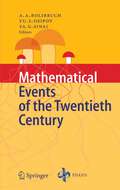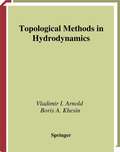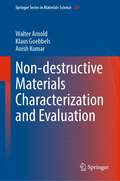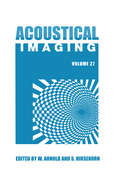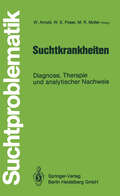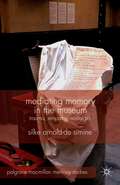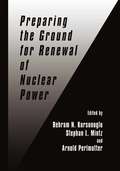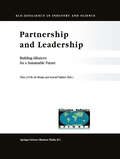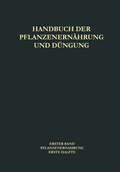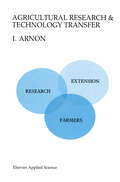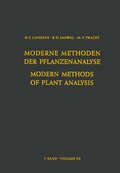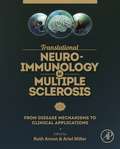- Table View
- List View
Natural Hybridization and Evolution (Oxford Series in Ecology and Evolution)
by Michael L. ArnoldThis study draws on data from numerous sources that support the paradigm of natural hybridization as an important evolutionary process. The review of these data results in a challenge to the framework used by many evolutionary biologists, which sees the process of natural hybridization as maladaptive because it represents a violation of divergent evolution. In contrast, this book presents evidence of a significant role for natural hybridization in furthering adaptive evolution and evolutionary diversification in both plants and animals.
Chemical Chaos (Horrible Science Ser.)
by Nick Arnold Tony De SaullesChemistry. It's the most _horrible_ part of science. The part that's most likely to make you say "UGH." Chemistry can cause chaos in your brain. Even teachers know it! But let's forget the fiendish formulas for now, and take a look at the nasty bits you REALLY want to know about - the nasty bubbling green mixtures, the vile and poisonous potions, the horrible smells, bangs and blasts. Discover: * how the first chemists - "alchemists" - really searched for the Philosopher's Stone * what suspect substances lurk in your school dinner * the sickening stench of the world's worst stink bomb * which cruel chemical gases poisoned soldiers in the war * how rotten reactions can blow you away! * which awful acids will eat you alive Flash a formula. Wave a test-tube. Potions bubble. Things go bang! It's not magic. You're not at Hogwarts. You've just read _Chemical Chaos_!
Killer Energy (PDF)
by Nick Arnold Tony De SaullesFans will love all the gory details of why space loos spray out frozen pee and which chilling chemical can preserve pets! With a fantastic new cover look and extra horrible bits at the back of the book, this best-selling title is sure to be a huge hit with a new generation of Horrible Science readers.
Vicious Veg (PDF)
by Nick Arnold Tony De SaullesScience with the squishy bits left in! How do plants suck out the insides of dead insects? Why do stinging nettles like skeletons? Which fungi can make your toes drop off? Get the awful answers in Vicious Veg!
Evolutionary Quantitative Genetics
by Prof Stevan J. ArnoldEvolutionary quantitative genetics (EQG) provides a formal theoretical foundation for quantitatively linking natural selection and genetic variation to the rate and expanse of adaptive evolution. It has become the dominant conceptual framework for interpreting the evolution of quantitative traits in terms of elementary forces (mutation, inheritance, selection, and drift). Despite this success, the relevance of EQG to many biological scenarios remains relatively unappreciated, with numerous fields yet to fully embrace its approach. Part of the reason for this lag is that conceptual advances in EQG have not yet been fully synthesized and made accessible to a wider academic audience. A comprehensive, accessible overview is therefore now timely, and Evolutionary Quantitative Genetics provides this much-needed synthesis. The central argument of the book is that an adaptive landscape concept can be used to understand both evolutionary process within lineages and the pattern of adaptive radiations. In particular, it provides a convincing argument that models with a moving adaptive peak carry us further than any other conceptual approach yet devised. Although additive theory holds center stage, the book mentions and references departures from additivity including non-Gaussian distributions of allelic effects, dominance, epistasis, maternal effects and phenotypic plasticity. This accessible, advanced textbook is aimed principally at students (from senior undergraduate to postgraduate) as well as practising scientists in the fields of evolutionary biology, ecology, physiology, functional morphology, developmental biology, comparative biology, paleontology, and beyond who are interested in how adaptive radiations are produced by evolutionary and ecological processes.
Pharmacoeconomics: From Theory to Practice
by Renee J. G. ArnoldThe pharmaceutical industry is almost boundless in its ability to supply new drug therapies, but how does one decide which are the best medicines to use within restricted budgets? With particular emphasis on modeling, methodologies, data sources, and application to real-world dilemmas, Pharmacoeconomics: From Theory to Practice provides an introduc
Getting Started in Radio Astronomy: Beginner Projects for the Amateur (The Patrick Moore Practical Astronomy Series)
by Steven ArnoldRadio astronomy is a mystery to the majority of amateur astronomers, yet it is the best subject to turn to when desirous of an expanded knowledge of the sky. This guide intends to instruct complete newcomers to radio astronomy, and provides help for the first steps on the road towards the study of this fascinating subject. In addition to a history of the science behind the pursuit, directions are included for four easy-to-build projects, based around long-term NASA and Stanford Solar Center projects. The first three projects constitute self-contained units available as kits, so there is no need to hunt around for parts. The fourth – more advanced – project encourages readers to do their own research and track down items. Getting Started in Radio Astronomy provides an overall introduction to listening in on the radio spectrum. With details of equipment that really works, a list of suppliers, lists of online help forums, and written by someone who has actually built and operated the tools described, this book contains everything the newcomer to radio astronomy needs to get going.
Radio and Radar Astronomy Projects for Beginners (The Patrick Moore Practical Astronomy Series)
by Steven ArnoldRadio and radar astronomy are powerful tools when studying the wonders of the universe, yet they tend to mystify amateur astronomers. This book provides a comprehensive introduction to newcomers, containing everything you need to start observing at radio wavelengths.Written by a mechanical engineer who has actually built and operated the tools described, the book contains a plethora of tested advice and practical resources. This revised edition of the original 2014 book Getting Started in Radio Astronomy provides a complete overview of the latest technology and research, including the newest models and equipment on the market as well as an entirely new section on radio astronomy with software-defined radios (SDRs). Four brand-new beginner projects are included, including bouncing a radar signal off the Moon, detecting the aurora, and tuning into the downlink radio used by astronauts aboard the ISS. Requiring no previous knowledge, no scary mathematics, and no expensive equipment, the book will serve as a fun and digestible reference for any level of astronomers hoping to expand their skills into the radio spectrum.
Anforderungen an Expertensysteme für den Gewässerschutz: Bedarfsanalyse, Systemkonzept und Machbarkeitsstudie
by Uwe Arnold Gerhard RouvéDynamical Systems IV: Symplectic Geometry and its Applications (Encyclopaedia of Mathematical Sciences #4)
by V. I. Arnol'D B. A. Dubrovin A. B. Givental' A. A. Kirillov I. M. Krichever S. P. NovikovFrom the reviews of the first edition:"... Here ... a wealth of material is displayed for us, too much to even indicate in a review. ... Your reviewer was very impressed by the contents of both volumes (EMS 2 and 4), recommending them without any restriction." Mededelingen van het Wiskundig genootshap 1992
Dynamical Systems V: Bifurcation Theory and Catastrophe Theory
by V.I. Arnold V.S. Afrajmovich Yu.S. Il'yashenko L.P. Shil'nikovBifurcation theory and catastrophe theory are two well-known areas within the field of dynamical systems. Both are studies of smooth systems, focusing on properties that seem to be manifestly non-smooth. Bifurcation theory is concerned with the sudden changes that occur in a system when one or more parameters are varied. Examples of such are familiar to students of differential equations, from phase portraits. Understanding the bifurcations of the differential equations that describe real physical systems provides important information about the behavior of the systems. Catastrophe theory became quite famous during the 1970's, mostly because of the sensation caused by the usually less than rigorous applications of its principal ideas to "hot topics", such as the characterization of personalities and the difference between a "genius" and a "maniac". Catastrophe theory is accurately described as singularity theory and its (genuine) applications. The authors of this book, previously published as Volume 5 of the Encyclopaedia, have given a masterly exposition of these two theories, with penetrating insight.
Gewöhnliche Differentialgleichungen (Springer-Lehrbuch)
by Vladimir I. Arnoldnen (die fast unverändert in moderne Lehrbücher der Analysis übernommen wurde) ermöglichten ihm nach seinen eigenen Worten, "in einer halben Vier telstunde" die Flächen beliebiger Figuren zu vergleichen. Newton zeigte, daß die Koeffizienten seiner Reihen proportional zu den sukzessiven Ableitungen der Funktion sind, doch ging er darauf nicht weiter ein, da er zu Recht meinte, daß die Rechnungen in der Analysis bequemer auszuführen sind, wenn man nicht mit höheren Ableitungen arbeitet, sondern die ersten Glieder der Reihenentwicklung ausrechnet. Für Newton diente der Zusammenhang zwischen den Koeffizienten der Reihe und den Ableitungen eher dazu, die Ableitungen zu berechnen als die Reihe aufzustellen. Eine von Newtons wichtigsten Leistungen war seine Theorie des Sonnensy stems, die in den "Mathematischen Prinzipien der Naturlehre" ("Principia") ohne Verwendung der mathematischen Analysis dargestellt ist. Allgemein wird angenommen, daß Newton das allgemeine Gravitationsgesetz mit Hilfe seiner Analysis entdeckt habe. Tatsächlich hat Newton (1680) lediglich be wiesen, daß die Bahnkurven in einem Anziehungsfeld Ellipsen sind, wenn die Anziehungskraft invers proportional zum Abstandsquadrat ist: Auf das Ge setz selbst wurde Newton von Hooke (1635-1703) hingewiesen (vgl. § 8) und es scheint, daß es noch von weiteren Forschern vermutet wurde.
Mathematical Events of the Twentieth Century
by Vladimir I. Arnold Ludwig Faddeev Yu. I. Manin V. B. Filippov Vladimir M. Tikhomirov Anatoly M. VershikThis book contains several contributions on the most outstanding events in the development of twentieth century mathematics, representing a wide variety of specialities in which Russian and Soviet mathematicians played a considerable role. The articles are written in an informal style, from mathematical philosophy to the description of the development of ideas, personal memories and give a unique account of personal meetings with famous representatives of twentieth century mathematics who exerted great influence in its development. This book will be of great interest to mathematicians, who will enjoy seeing their own specialities described with some historical perspective. Historians will read it with the same motive, and perhaps also to select topics for future investigation.
Topological Methods in Hydrodynamics (Applied Mathematical Sciences #125)
by Vladimir I. Arnold Boris A. KhesinThe first monograph to treat topological, group-theoretic, and geometric problems of ideal hydrodynamics and magnetohydrodynamics from a unified point of view. It describes the necessary preliminary notions both in hydrodynamics and pure mathematics with numerous examples and figures. The book is accessible to graduates as well as pure and applied mathematicians working in hydrodynamics, Lie groups, dynamical systems, and differential geometry.
Non-destructive Materials Characterization and Evaluation (Springer Series in Materials Science #329)
by Walter Arnold Klaus Goebbels Anish KumarThis book is devoted to non-destructive materials characterization (NDMC) using different non-destructive evaluation techniques. It presents theoretical basis, physical understanding, and technological developments in the field of NDMC with suitable examples for engineering and materials science applications. It is written for engineers and researchers in R&D, design, production, quality assurance, and non-destructive testing and evaluation. The relevance of NDMC is to achieve higher reliability, safety, and productivity for monitoring production processes and also for in-service inspections for detection of degradations, which are often precursors of macro-defects and failure of components. Ultrasonic, magnetic, electromagnetic and X-rays based NDMC techniques are discussed in detail with brief discussions on electron and positron based techniques.
Acoustical Imaging (Acoustical Imaging #27)
by Walter Arnold Sigrun HirsekornAcoustical imaging has become an indispensable tool in a variety of fields. Since its introduction, the applications have grown and cover a variety of techniques, producing significant results in fields as disparate as medicine and seismology. Cutting-edge trends continue to be discussed worldwide. This book contains the proceedings of the 27th International Symposium on Acoustical Imaging (AI27), which took place in Saarbrücken, Germany, from March 24th to March 27th 2003. The Symposium belongs to a conference series in existence since 1968. AI27 comprised sessions on: Medical Imaging, Non-Destructive Testing, Seismic Imaging, Physics and Mathematics of Acoustical Imaging, Acoustic Microscopy. During two well-attended workshops the applications of quantitative acoustical imaging in biology and medical applications, and in near-field imaging of materials, were discussed. Based on its cross-disciplinary aspects, the authors of the papers of AI27 present experiments, theory and construction of new instruments.
Suchtkrankheiten: Diagnose, Therapie und analytischer Nachweis (Suchtproblematik)
by Wolfgang Arnold Wolfgang E. Poser Manfred R. MöllerDas Buch enthält die Beiträge der ersten gemeinsamen Tagung der Gesellschaft für Toxikologie und Forensische Chemie und der Gesellschaft für Suchtforschung zum Thema "Die Bedeutung chemisch-toxikologischer Analysen von Suchtstoffen - Diagnostische, forensische und therapeutische Maßnahmen". Bei der Analyse biologischer Asservate von Drogenabhängigen gelingt es mit Hilfe des Einsatzes zweier von einander unabhängiger Untersuchungsverfahren, fast immer zu eindeutigen Ergebnissen zu kommen. Damit wird eine weitgehend sichere Interpretation der Befunde ermöglicht. Die Zunahme der Rauschgifttodesfälle in den letzten Jahren muß als eine dringliche Aufforderung zu einer engeren Zusammenarbeit aller Beteiligten angesehen werden. Namhafte Experten behandelten in ihren Vorträgen aktuelle Fragen zu einem aktuellen Thema.
Mediating Memory in the Museum: Trauma, Empathy, Nostalgia (Palgrave Macmillan Memory Studies)
by S. Arnold-de-Simine Silke Arnold-de SimineMediating Memory in the Museum is a contribution to an emerging field of research that is situated at the interface between memory studies and museum studies. It highlights the role of museums in the proliferation of the so-called memory boom as well as the influence of memory discourses on international trends in museum cultures.
Preparing the Ground for Renewal of Nuclear Power
by ArnoldPerlmutter Stephan L. Mintz Behram N. KursunogluThis conference proceedings explores issues surrounding the replacement of existing nuclear power plants when they reach the end of their useful life. Topics covered include: Nuclear competitiveness regarding politics and power plant evolution; social acceptance regarding communication, information, waste, and safety proliferation; and durability regarding resources and effects on the environment.
Partnership and Leadership: Building Alliances for a Sustainable Future (Eco-Efficiency in Industry and Science #8)
by ArnoldTukker Theo J. N. M.BruijnSustainable development has become a central perspective in environmental strategies around the world. It is clear that neither governments nor businesses have the capability to bring about sustainability on their own. Therefore, collaboration has emerged as a central concept. At the same time it is obvious that someone has to take the lead in the development towards sustainability. This book focuses on different forms of collaboration emerging between various actors. The objective of the book is to more systematically explore the different roles and relationships between partnership and leadership. Basically, both partnership and leadership can be seen in a positive and negative way: for example, as far as partnership is concerned, we can assume that the path towards sustainability can be paved by parties coming together, taking some initiative collaborating. On the opposite, partnership and consensus-based decisions can be seen as an obstacle to foster radical changes in production and consumption patterns. Similarly, leadership can be seen as an obstacle to sustainable development if leaders form close circles and are not willing to share experiences with other actors; but leadership could also be considered as an important element to keep concepts and practices forward. The book holds this double perspective: explaining, mapping and analyzing different goals/formats/methods of more and less collaborative approaches, but at the same time taking a critical approach to the theme by understanding related risks, effects, prospects and corrective actions. Next to a conceptual part, the book brings together case-studies from around the world. The focus is in describing and understanding various formats of collaboration and critically evaluating its effects and prospects. A concluding chapter discusses the role of partnership and leadership in realizing various levels of environmental innovations: optimization and re-design, that usually affect only a small part of the production/consumption structure, and much more complicated, radical innovations that have to deal with societal (sub)systems. The book is in part an edited version of selected papers presented during the 1998 Greening of Industry Conference in Rome on the subject, enriched with contributions of other invited authors.
Pflanzenernährung (Handbuch der Pflanzenernährung und Düngung #1 / 1)
by D. I. Arnon W. Baumeister W. U. Behrens E. v. Boguslawski M. J. Bukovac H. Burghardt M. Erichsen W. Flaig W. H. Fuchs F. Grossmann F. Heilinger G. P. Hill J. Jung H. Kick J. G. Kisser P. J. Kramer H. Kühn P. Limberg H. Linser H. H. Mayr K. Mengel K.-H. Neumann K. Scharrer G. Schmid W. Schuster H. B. Tukey H. Walter S. H. WittwerSeit dem Erscheinen des zweibändigen Standardwerkes von F. HoNCAMP, "Handbuch der Pflanzenernährung und Düngerlehre", sind mehr als dreißig Jahre vergangen. Bei den stürmischen Fortschritten auf allen Gebieten der Natur wissenschaften, insbesondere der Chemie, Pflanzenphysiologie, Biochemie, Bodenkunde und Technologie, ist dieses zur Zeit seines Erscheinens so aus gezeichnete Handbuch natürlich längst veraltet. Zweifellos besteht heute ein dringendes Bedürfnis nach einem ähnlichen Werk. Wenn wir von dem ursprünglichen Plan abgekommen sind, das HoNCAMP sche Handbuch in neuer Auflage zu bearbeiten, so vor allem deswegen, weil die tiefgreifende Entwicklung auf diesem Gebiet eine völlig neue Gestaltung des Werkes geboten erscheinen ließ. Es gliedert sich nun in drei Bände. Band I behandelt im wesentlichen die physiologischen Grundlagen der Pflanzenernährung. Er enthält eine ausführliche und systematische Darstellung der eigentlichen Ernährungsphysiologie. Auf eine Erörterung der allgemeinen pflanzenphysiologischen Grundlagen konnte dabei verzichtet werden, weil im RuHLANDschEin "Handbuch der Pflanzenphysiologie" ein umfassendes und modernes Nachschlagewerk zur Verfügung steht. Band II beschäftigt sich mit dem Boden und den Düngemitteln. Unter Berücksichtigung der modernen Agrikulturchemie haben wir das heutige Wissen über den Boden als Standort und Nährstoffquelle der Pflanze unter den Verhält nissen der landwirtschaftlichen Praxis und des Gartenbaues bzw. des Forstwesens systematisch zusammengefaßt. Die folgenden Kapitel befassen sich mit der Beschreibung und Herstellung der verschiedenen Wirtschafts- und Handels düngemittel. Gerade auf diesem Gebiet bestehen in der wissenschaftlichen Literatur erhebliche Lücken, da keine größeren Lehr- oder Handbücher vorhanden sind, die sich eingehender mit der Technologie der Düngemittel und der Düngung beschäftigen.
Agricultural Research and Technology Transfer
by Isaac ArnonAgricultural research was probably the first and is the most widespread form of organised research in the world, and one in which both the most developed and underdeveloped countries are engaged. Whilst most forms of research activity, such as in the field of medicine, have world wide application, agricultural research, by its very nature, has to be regional; practically no research finding can be adopted without studying the results of its application under the infinite number of ecological situations with which the farmers of the world are faced. The improvement of agricultural production is the essential first step whereby developing countries can hope to raise their standard of living. Research is therefore an activity in which no underdeveloped country can afford not to engage; nor can countries in which agriculture has reached a high level of development and sophistication afford to neglect agricultural research. It is not because of inertia or vested interests that highly industrialised countries maintain, mostly at public expense, a costly and complex infrastructure for agricultural research. Even when problems of overproduction weigh heavily on the economy, agricultural research is considered the essential key to further progress: the objectives and goals are simply changed and adapted to the needs of the economy.
Modern Methods of Plant Analysis / Moderne Methoden der Pflanzenanalyse (Modern Methods of Plant Analysis Moderne Methoden der Pflanzenanalyse #7)
by Israel ArnonTranslational Neuroimmunology in Multiple Sclerosis: From Disease Mechanisms to Clinical Applications
by Ruth Arnon Ariel MillerMultiple sclerosis (MS) is the most common disabling neurological disease of young adults. More than 2.3 million people are affected by MS worldwide. Symptoms can vary widely, depending on the localization and amount of the damage induced by combined inflammatory, demyelinating, and neurodegenerative processes. Although a cure for MS does not currently exist, therapies can help treat MS attacks, attenuate disease activity, reduce progress of the disease, and manage symptoms. Translational Neuroimmunology in Multiple Sclerosis provides an overview of recent findings and knowledge of the neuroimmunology of multiple sclerosis, from experimental models and the human disease to the translation of this research to immunotherapeutic strategies. Chapters describe genetic and environmental factors underlying the disease pathogenesis of MS as a basis for development of immunotherapies, immunological markers of disease activity, pharmacogenetics, and responses to therapy. Immunomodulatory therapies currently in practice and future therapeutic strategies on the horizon—such as neuroprotective strategies, stem cells, and repair promotion—are discussed. Contributed by renowned leaders in the field, this cross-disciplinary volume is a great resource for basic scientists and clinical practitioners in neuroscience, neurology, immunology, pharmacology, and in-drug development.Provides an overview of recent findings and knowledge of the neuroimmunology of multiple sclerosis and the translation of this research to immunotherapy treatmentEdited by renowned leaders in the field of neuroimmunology and multiple sclerosisContains the latest resource material for basic and clinical scientists and practitioners in neuroscience, neurology, immunology, and pharmacology2017 BMA Medical Book Awards Highly Commended in Neurology
